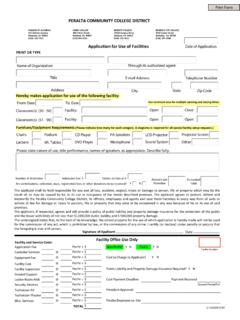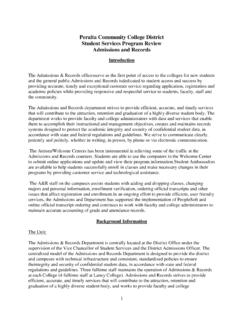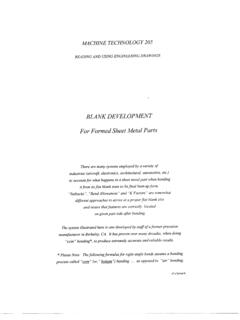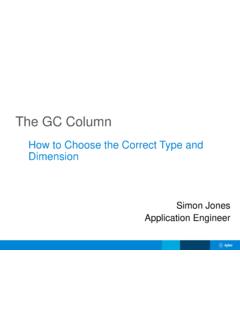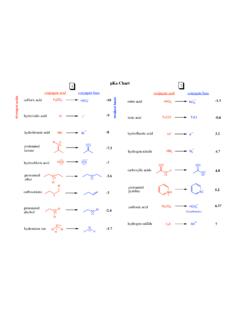Transcription of Handout: Naming Organic Compounds
1 H. Kim for Chem 30B 1 Handout: Naming Organic Compounds A. IUPAC Naming General Rules: Prefix + Parent + Suffix 1. Name parent+suffix: longest carbon chain + family suffix. 2. Number carbons in parent chain: Begin numbering from end that meets specified criteria (*See Nomenclature Chart). 3. Name prefix: substituent position #s and names (grouping repeated substituents together using di-, tri-, etc). 4. Write full name, listing substituents in alphabetical order (ignoring di-, tetra- in alphabetizing). Some Parent Alkane Names No. of Carbons Structure Name 1 CH4 Methane 2 CH3CH3 Ethane 3 CH3CH2CH3 Propane 4 CH3 CH2CH2CH3 Butane 5 CH3 CH2CH2CH2CH3 Pentane 6 CH3 CH2CH2CH2CH2CH3 Hexane 7 CH3CH2CH2CH2CH2CH2CH3 Heptane 8 CH3CH2CH2CH2CH2CH2CH2CH3 Octane 9 CH3CH2CH2CH2CH2CH2CH2CH2CH3 Nonane 10 CH3CH2CH2CH2CH2CH2CH2CH2CH2CH3 Decane Some Substituent Names Substituent Group Substituent Name Specific Examples Hydrocarbon with single bonds only alkyl methyl ethyl isopropyl isobutyl sec-butyl tert-butyl acyl (Ends with oyl, except for acetyl) acetyl propanoyl OR alkoxy methoxy ethoxy formyl keto OH hydroxy -NO2 nitro NH2 amino -X (halogen)
2 Halo -Cl chloro -Br bromo -I iodo phenyl H3CH3CH2 CCHCH3H3 CCHH2 CCH3H3 CCHH2CH3 CCH3 CCH3H3 CCH3 RCOH3 CCOCH2 COH3CH3CH3CH2 CHCOCOS ubstituents Longest carbon chain Family Name Format: # substituent # substituentparentsuffix H. Kim for Chem 30B 2 B. Common Names Some Widely-Used Common Names compound Common Name IUPAC Name CH2=CH2 ethylene 1-ethene CH3CH=CH2 propylene 1-propene acetylene 1-ethyne acetone 2-propanone formaldehyde methanal acetaldehyde ethanal formic acid methanoic acid acetic acid ethanoic acid propionic acid propanoic acid butyric acid butanoic acid HCCHH3 CCOCH3CH2 OCHOH3 CHCOOHCOOHH3 CCOOHCH2H3 CCOOHCH2H2CH3C H. Kim for Chem 30B 3 Nomenclature Chart for Organic Compounds (From HIGHEST TO LOWEST Naming priority) FAMILY PARENT SUFFIX NUMBERING NOTES EXAMPLES Carboxylic acid Parent is longest carbon chain containing carboxylic acid.
3 Derive name from parent alkane. oic acid (-dioic acid for dicarbox-ylic acid; -enoic acid for unsatur-ated acid) Begin at carbonyl C. Common names are often used (C next to COOH group is designated as ). [Salts: cation + name derived from parent acid, replacing ic acid with ate ] 2-chloropropanoic acid or -chloropropionic acid (common) Ester Name of alkyl group that replaced -H in -COOH + name derived from parent acid, replacing ic acid with ate ate Begin at carbonyl C. Common names are often used: name of alkyl group that replaced -H in -COOH + name derived from common name of parent acid, replacing ic acid with ate ethyl butanoate or ethyl butyrate (common) Amides Derive name from parent carboxylic acid, replacing oic acid with amide.
4 Amide Begin at carbonyl C. Alkyl substituents on nitrogen start with N-. N,N-dimethylacetamide Aldehydes Derive name from parent alkane. al Begin at carbonyl C. Common names are often used for simplest aldehydes, ending with aldehyde. 3-methylbutanal or -methylbutyraldehyde (common) Ketones Derive name from parent alkane. Parent name starts with position # of carbonyl C. one Begin at end nearer to carbonyl C. Common names are often used for simple ketones: names of two alkyl groups + ketone. 2-pentanone or methyl propyl ketone (common) Alcohol Parent is longest carbon chain containing OH. Parent name starts with position # of the C with OH. ol (-diol, -triol, etc.) Begin at end nearer to OH group.
5 Cyclic alcohols: Parent name begins with cyclo (no need to start parent name with 1 ). Begin numbering at C with OH, and number to give substituents lowest numbers. 5-methyl-3-hexanol 2-methylcyclohexanol 1,3-butanediol Thiols thiol Name in same way as alcohols, except end with -thiol. ethanethiol HCCOOHH3 CClH2 CCOOH2CH3CH2 CCH3H3 CCONCH3CH3 COHH2 CCHH3 CCH3H2 CCOCH3H2CH3CH3 CCHH2 CCHH2 CCH3CH3 OHOHCH3H3 CCHH2CH2 COHOHH3CH2 CSH H. Kim for Chem 30B 4 FAMILY PARENT SUFFIX NUMBERING NOTES EXAMPLES Amines amine 1 amines, and 2 , 3 amines with same R groups on N: Treat alkyl groups attached to nitrogen as substituents. For same substituents, use di and tri. 2 , 3 amines with different R groups on N: Parent amine is the one with largest R group; name other groups as substituents, starting with N.
6 [Ions derived from amines: Replace amine with ammonium.] (1 ) propylamine (3 with same R groups) triethylamine (2 with diff t R groups) N-methylpropanamine Alkenes alkynes Parent is longest carbon chain containing the double or triple bond. Parent name starts with position number of multiple bond. May need cis/trans designation. ene yne (-diene, -triene, etc.) Begin at end closer to multiple bond. (If multiple bonds are equidistant, give smaller number to first branch point). Then give smallest numbers possible to substituents. Cyclic alkenes: Parent name begins with cyclo (no need to start parent name with 1 ). Number multiple bonds 1 and 2, in direction to give first substituent the next smaller possible number.
7 Cis-4-methyl-3-heptene 2-heptyne 4-methylcyclohexene Alkanes Parent is longest carbon chain. ane Begin at end nearer to branch point. Then give smallest numbers possible to substituents. Cyclic alkanes: Parent name begins with cyclo. Give smallest number to substituent that comes first in alphabetical order. Number in direction to give second substituent the smaller possible number. (If single substituent, don t need 1-. ) 4-ethyl-2-methylhexane 1-ethyl-3-methylcyclohexane Ethers The alkoxy group OR is treated as the substituent (Alkane or another functional group is the parent). Common names are often used for simple ethers: two R groups + ether. Common names are used for cyclic ether Compounds . 1-ethoxypropane or ethyl propyl ether (common) 3-ethoxypropanol H3CH2CH2 CNH2H3CH2CH2 CHNCH3 CCH2 CHCH2CH2CH3CH3H3CH2CH2 CCCCH3H2CH3CH3 CCHH2 CCH3 HCH2 CCH3H2 CCH3H2CH3 CCH3H2 COH2CH2 CCH3H3CH2 COH2CH2CH2CH3 COHH3CH2 CNH2CH2 CCH3CH3CH3 H.
8 Kim for Chem 30B 5 Haloalkanes (or Alkyl Halides) Halogen atom is treated as substituent (Alkane or another functional group is the parent). Common names are often used, in format alkyl halide. 1-bromoethane or ethyl bromide (common) aromatic Nomenclature (*Functional group priority is same in aromatic and aliphatic nomenclature.) FAMILY PARENT SUFFIX NUMBERING NOTES EXAMPLES Benzene benzene or common name for substituted benzene For di-substituted benzenes, o, m, p typically used for positions of substituents. o- m- p- Common names for substituted benzenes are often used (accepted by IUPAC): Toluene Phenol Benzaldehyde Benzoic acid Aniline m-chloronitrobenzene p-nitrophenol H2 CBrH3 CCH3 OHCHOCOOHNH2NO2 ClOHO2N



